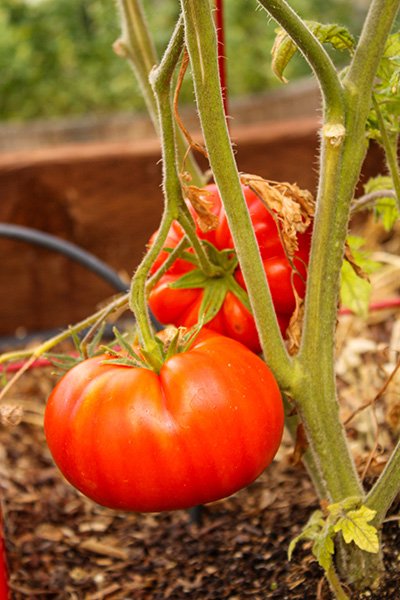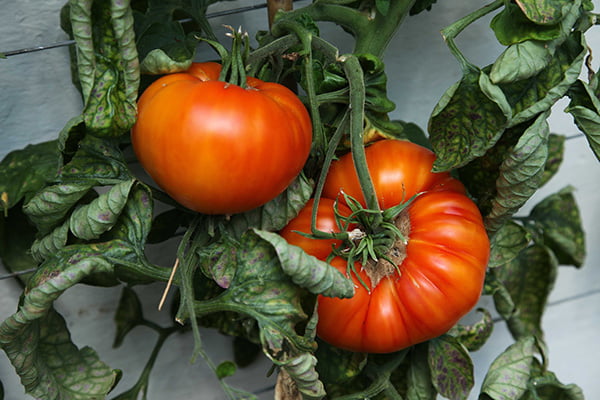If you love big, juicy homegrown tomatoes, nothing beats tried-and-true beefsteak tomatoes. In fact, beefsteak tomato plants are the most popular variety of tomatoes for home gardening. And with some love and affection, you can enjoy harvest after harvest of beefsteaks all summer long.
To help you successfully grow a garden full of ripe, juicy tomatoes, we've created this beginner's guide to growing beefsteak tomatoes. We'll cover everything you need to know from germination to harvest and provide helpful advice on every stage in between.
What are beefsteak tomatoes?
Beefsteak tomatoes are one of the most popular types of tomatoes for home gardening, as they typically grow quickly and are relatively easy to care for. While you can find them during the summer at farmer's markets and fruit stands, you'll rarely see them sold in grocery stores, as they are not well-suited for mechanized growing on a commercial scale.
As one of the larger tomato varieties, they produce massive fruits weighing upwards of a pound; some even grow to be two pounds or more! Their large size and juicy slices make them a popular choice for topping sandwiches and burgers, cooking in pasta dishes, or serving plain. Most beefsteak tomatoes are pink or red in color, while some hybrid and heirloom varieties can be yellow or orange too.
Popular Beefsteak Tomato Varieties
There are many varieties of beefsteak tomatoes, each boasting a slightly different shape, flavor, and color. Here are a few of the most popular beefsteak tomato varieties:
Big Beef — A great all-around tomato thanks to its meaty texture, large core, and disease resistance
Heirloom Beefsteak— Beautiful colors but less disease resistant and often less flavorful
Beefmaster— Solid, meaty tomatoes that are disease resistant and tolerant to cracking
Brandywine— One of the most popular heirloom varieties thanks to their large size fruit and delicious flavor
Cherokee Purple— Heirloom tomato variety with a purplish tint and rich flavor
Celebrity— Known for their excellent flavor, great for making salsas and sauces
Burpee 'Early Pick VF' Hybrid— A fast-growing hybrid that produces fruit earlier than wide heirloom varieties
How tall do beefsteak tomato plants grow?
New gardeners often underestimate exactly how big their beefsteak tomato plant can— and will— grow. A beefsteak tomato plant can grow to be around eight feet tall and two to three feet wide at full size. You'll need to leave at least two to three feet between your tomatoes and other garden vegetables.
How long does it take for a beefsteak tomato to grow?
Beefsteak tomatoes are indeterminate plants and usually require around one hundred days to reach maturity. Remember, beefsteak tomatoes picked at peak ripeness have a fuller flavor than those ripened off the vine. Prepare to wait at least three months after transplanting to begin harvesting fruit.
How many tomatoes does a beefsteak plant produce?
The average beefsteak tomato plant produces around fifteen to twenty-five pounds of fruit, ranging from twenty to fifty tomatoes, depending on the plant. You can encourage your plants to produce larger fruit in large quantities by supporting them with a trellis or tomato cages and giving them plenty of water, sunshine, and nutrients.

Source: Unsplash
How to Grow Beefsteak Tomatoes:
Growing Beefsteak Tomatoes from Seed
Compared to other tomato varieties, beefsteak tomatoes require a long growing season to produce their large-sized fruit. Because they take around 100 days to mature, you'll want to plant them a week or two after the final spring frost has passed.
If you're growing your plants from beefsteak tomato seeds, you'll want to start growing at least 4 to 6 weeks earlier so they can reach the proper size before your anticipated transplanting date. Tomato plants love warm soil, and seed germination occurs fastest in soil that's between 60-90 degrees. Be sure to harden off your seedlings to prevent shock after transplanting.
Planting Beefsteak Tomato Plants
While planting beefsteak tomatoes is pretty straightforward, there are a few things you'll need to keep in mind:
Plant Your Seedlings Deep— Beefsteak tomatoes should be planted deeper than most plants. When planting, set them in the ground deep enough that the soil almost reaches the lowest leaves. This helps keep their roots warm during cold temperatures and supports the growth of a stronger root system.
Spacing is Key to Success— Beefsteaks can grow to be pretty large, so you'll want to space them at least 36 inches apart from other plants.
Companion Plants— Tomatoes grow well next to garlic, roses, carrots, asparagus, onion, and chives. Avoid planting tomatoes next to vegetables from the Brassicaceae family (cabbage, broccoli, kale, radishes, cauliflower, turnip), potatoes, corn, and fennel herbs.
Provide Proper Support— To encourage proper plant growth, your tomato plants should be tied to a trellis, cage, or garden stakes. This support helps protect your plants from blossom end rot.
Pinch Early Shoots— Pinching early shoots encourages upward growth and early fruit production, especially when plants are caged.
Beefsteak Tomato Plant Care Requirements
Soil
Like all tomato plants, beefsteak thrives in well-drained soil rich with organic matter. They thrive in slightly acidic soil, with a pH level between 6.0 and 6.8. The soil should be loose and nutrient-rich to allow for good air circulation and reduce disease risk.
To create nutrient-rich soil, supplement the soil with fertilizer, compost, or other organic matter rich in potassium, phosphorus, and nitrogen. Most gardening experts recommend mulching your tomato plants with either red or black plastic mulch to keep the soil evenly moist and ward off weeds.
Light
Tomato plants thrive in full sun conditions. Be sure to place them somewhere that gets six to eight hours of direct sunlight daily.
Water
Beefsteak tomatoes require one to two inches of water per week. Depending on when and where your tomatoes are being grown, they'll need watering either every day or every other day. When growing tomatoes in pots, you'll need to water them daily (sometimes even twice daily) during hot summer weather. When watering, stick to watering on the ground to discourage end rot.
Common Problems With Beefsteak Tomato Plants
It's easy to grow beefsteak tomatoes, but you will need to be on guard against certain common problems!
Common Pests
Tomato hornworms are huge, green caterpillars that will make your skin crawl! They're harmless to you, despite their size, but they will eat all of the fruit from your plant. The easiest way to fight them is to remove them. The hornworms blend in, but they're large, so you'll be able to find them if you look. Check the underneath of leaves for white eggs, as well.
Flea beetles are a common problem when growing beefsteaks and will destroy the leaves. Treating the soil with diatomaceous earth will prevent them, and spraying the plant with neem oil will handle any beetles that hatch.
Common Diseases
Tomatoes are prone to fungal diseases, such as blossom end rot and late blight. Be sure to plant tomatoes in well-drained soil, with ample space between the plants. Mulching will also help prevent fungal disease, and black plastic mulch is particularly helpful for resistance against blossom end rot.

Source: Pixabay
Harvesting Beefsteak Tomatoes
Harvest your tomatoes once they've fully ripened and reached their peak color to maximize flavor. While it varies based on the variety, climate, and growing conditions, it usually takes between at least 80 to 90 days.
Growing Tips
Beefsteak tomatoes are a large plant! They take up lots of room, and they must receive good air circulation. Give a minimum of 36 inches between two plants, and up to 5 feet of space between seedlings is ideal.
While many smaller tomato varieties, such as cherry tomato plants, receive plenty of support with a standard tomato cage, beefsteak tomato plants simply get too large and heavy. They will require trellising.
Keep in mind that members of the Brassicaceae family also require large amounts of these nutrients, so when planning your vegetable garden, separate your beefsteak tomatoes from turnips, kale, and cauliflower. This way, they won't be competing for the same nutrients!
Are Beefsteak Tomato Plants Pet Friendly?
Yes, beefsteak tomatoes are safe for pets to eat, and the leaves and stem are nontoxic, and the tasty fruit can benefit dogs and cats. However, tomato fruits are highly acidic and can cause stomach upset.
How to Use Beefsteak Tomatoes
Once your garden is overflowing with ripe tomatoes, you'll need to come up with some new tasty ways to enjoy them! Here are a few of the most popular ways to use beefsteak tomatoes:
Slicing for sandwiches, hamburgers, and paninis
Pasta sauces like marinara or bolognese
Tomato soups and stews
Salsas, chutneys, and dressings
Salads like Caprese or Mediterranean salad
Pizza toppings
Bruschetta
Served plain with a drizzle of olive oil
